114/20: supplementary guidance for the safety at street works and road works a code of practice 2013
This guidance advises on street works and road works on active travel routes.
This file may not be fully accessible.
In this page
Addressing the needs of pedestrians and cyclists when carrying out street works and maintenance activities.
Instructions for use
This guidance document details procedures for noticing, designing and implementing street works and road works on active travel routes. It is to be used by officers involved in the administration, design and operation of street works and road works.
Introduction
1.1 This guidance note is issued by the Welsh Government and sets out procedures for managing street works, road works and associated maintenance activities wherever they may impact on walkers and cyclists. It provides supplementary guidance to the 'Safety at street works and road works: a code of practice 2013' (the Red Book) in anticipation of this being updated in the future. The Welsh Government’s aim is to dramatically increase the number of people walking and cycling for everyday journeys and managing street works, road works and maintenance activities is key to facilitating this. People will only substitute walking or cycling for a car journey if the available route is safe, comfortable, coherent and direct. Whilst cyclists and pedestrians should always be accommodated within road and street works the significance of active travel routes is that they attract a wider range of users.
1.2 The Active Travel (Wales) Act 2013 imposes duties on local authorities, meaning county councils or county borough councils. Local authorities have several functions including ‘highway authority’ and ‘street authority’ functions. A local authority in its capacity as a street authority exercises functions under the New Road and Street Works Act 1991 in relation to street works carried out by statutory undertakers (or licensed persons), whilst road works are carried out by the highway authority in exercise of functions under the Highways Act 1980. The Traffic Management Act 2004 made several changes to the New Road and Street Works Act 1991 which are relevant and referenced in the document. Within this guidance note the terms local authority, street authority and highway authority are used in line with the duty being performed.
1.3 The Active Travel (Wales) Act 2013 came into force in Wales in September 2014 and places several duties on local authorities and the Welsh Ministers. This guidance should be used by those planning, designing and executing street works and road works that affect all roads where walking and cycling is permitted, including designated active travel routes. It is important that all active travel modes are provided with accessible, safe and convenient routes at street works and road works.
1.4 This document is supplementary to the legislative and regulatory provisions in the 'Safety at street works and road works: a code of practice 2013' (the Red Book) and guidance found in chapter 8 of the 'Traffic signs manual 2009'. These provisions are available for use on the network and shall be subject to suitable risk assessments being in place. This document provides operational advice to supplement the Welsh Government’s 'Active travel guidance'.
1.5 This guidance applies to both the local authority road network and the trunk road network for which the Welsh Ministers are the highway authority.
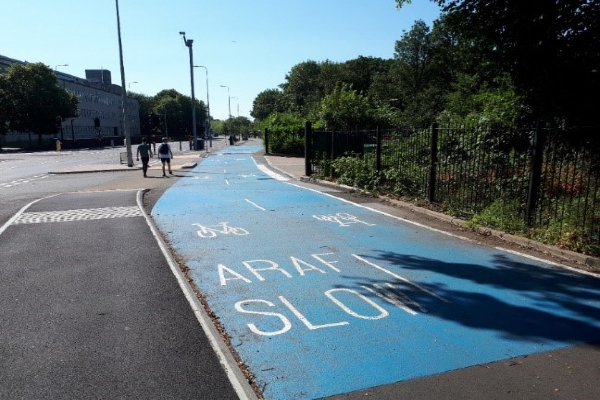
1.6 Poorly planned traffic management can cause danger to pedestrians and cyclists or make routes inaccessible to disabled people. Even if the actions are unintentional, e.g. parking a works vehicle on the footway, they can easily cause an obstruction to the route which places pedestrians and cyclists at risk in negotiating around the vehicle or the street works or road works site. This perceived obstruction can make the whole journey unattractive to users and cause them to switch to a less sustainable travel mode. This guidance note helps designers, planners and operatives to plan and execute their works without causing these problems.
1.7 A full explanation of powers and duties for national and local authorities with relevance to the Active Travel (Wales) Act 2013 is included in the Active Travel Act Guidance issued by the Welsh Ministers.
1.8 This PAG is in 2 parts:
Part 1: Planning street works and road works
2. Active travel
2.1 The Welsh Government aims to make active travel the most attractive option for shorter journeys, thus displacing journeys by car. An important aspect is the creation of local route networks for walking and cycling. The objective is to increase the rates of walking and cycling which will directly contribute to the Welsh Government’s aims for sustainable development and improve the health and wellbeing of the nation.
2.2 The Active Travel (Wales) Act 2013 places a requirement on local authorities in Wales to produce active travel maps and secure every year new active travel routes and improvements to existing active travel routes and facilities. It requires highways authorities in Wales to make enhancements to routes and facilities for pedestrians and cyclists in all new road schemes and to have regard to the needs of walkers and cyclists in other highway authority functions such as undertaking routine maintenance and making highway improvements. It also requires the Welsh Ministers and local authorities to promote active travel journeys in exercising their functions under this Act.
2.3 Local authorities are required to have regard to the Active Travel (Wales) Act 2013 when exercising their other statutory functions as a street and highway authority. The duties under the Act are placed on the local authorities generally and also apply to the Welsh Ministers in their capacity as highway authority for the trunk road network.
2.4 Under part 3 of the New Roads and Street Works Act 1991, local authorities and statutory undertakers must have regard to the needs of walkers and cyclists in:
- granting street works licences;
- giving directions as to the timing of street works;
- the placing of apparatus;
- restricting street works following substantial road works;
- exercising their duty to co-ordinate works, and
- giving consent to place apparatus on a protected street
2.5 Local authorities, highway authorities and statutory undertakers should consider the effects that street works and road works may have on walkers and cyclists and addressing this will form part of the co-ordination process. Street authorities should seek to minimise any disruption for walkers and cyclists when giving any directions or placing any restrictions on street works.
3. The mapping process
3.1 Local authorities have defined their existing active travel routes and these are shown on Existing Route Maps (ERM) which were approved by the Welsh Ministers. These maps are generally aimed at the general public giving them basic information in order that they can see where these routes are and plan journeys accordingly. In addition local authorities have identified proposed routes which are planned to be implemented within the short, medium and longer term (15 years).
3.2 These are shown on the Integrated Network Maps (INM). These maps are usually published on the local authorities’ websites. The ERM and INM will in future be merged into a single Active Travel Network Map showing existing routes and the proposed additions and improvements. Therefore the term ‘active travel network map’ is used within this guidance note when referencing any of the maps.
4. Associated street data
4.1 The active travel network maps on the local authority active travel websites do not provide adequate referencing for street works in their current form. Local authorities should define their routes as Associated Street Data so that these are recorded on the National Street Gazetteer (NSG) enabling works promoters to accurately identify their locations. Further information about the NSG can be found on the following website: National Street Gazetteer
4.2 Dependent upon the strategic importance of the active travel route and whether there are any special features the information that can be attributed to the street and recorded in the NSG could include:
- define the route as traffic sensitivity (enabling works to be prohibited at certain times)
- define the route as a street with special engineering difficulties/ special construction needs
- define the streets that form part of a strategic route
- define the route as a priority lanes.
These criteria are advisory only and inclusion of the active travel information in one of these categories will need to be agreed with the statutory undertakers.
4.3 However, it is essential that street authorities are consistent in the way active travel routes are recorded so statutory undertakers can easily pick up this information. Welsh HAUC is currently working with Geoplace to determine the appropriate code or whether an unused code can be reactivated specifically for active travel routes.
4.4 Active travel route details will need to be added as further comments within the local considerations area of the code.
4.5 It is essential that local authorities update the NSG with active travel routes and this will require liaison between the active travel officer and the street works team. Welsh Government will request health check data reports from Geoplace to check on the compliance by street authorities.
4.6 The active travel network maps provide basic information for forward planning which should be included in coordination meetings. The details shown on the local authorities’ websites are insufficient to enable forward planning notices to be determined, but do provide an outline of the local authorities’ intentions.
5. Co-ordination
5.1 Sections 59 and 60 of the New Roads and Street Works Act 1991 make provision for the control and co-ordination of street works. The street authorities are responsible for the co-ordination of works on its own roads. Section 59 requires the street authority to use its ‘best endeavours’ to co-ordinate street works and section 60 requires that the undertakers should use their ‘best endeavours’ to co-operate with the street authority and with other undertakers. The co-ordination processes are set out in the Co-ordination Code of Practice (Wales) (January 2008). The use of electronic transfer of notices relating to street works and road works to street authorities is encouraged.
5.2 Provided the street authority has accurately updated the NSG, the statutory undertakers will be expected to plan their works around active travel routes. If active travel routes have not been identified on the NSG, then street authorities should inform statutory undertakers using comments on the notice.
5.3 Sections 51 and 52 of the Traffic Management Act 2004 made changes to the New Roads and Street Works Act 1991 which provides more control over when works may be carried out. For example section 58 of the New Roads and Street Works Act 1991 allows the street authority to restrict the execution of street works on parts of the highway which have been subject to substantial road works (for example, reconstruction or resurfacing) for a specified period of time up to a maximum of 5 years. This can include major active travel infrastructure, such as where segregated cycle tracks have been specifically constructed for major cycle routes.
5.4 Once a notice has been issued detailing the restriction, no street works can be carried out during the specified period without the consent of the street authority. Certain works including service connections after a 21 day period and emergency works are exempt from these restrictions (Section 6.5.1 Coordination Code of Practice). Section 43(2) of the Traffic Management Act 2004 amended the New Roads and Street Works Act 1991 to make it clear that street authorities may give directions as to both timing and days of work.
5.5 Furthermore the street authority can, in certain circumstances, direct undertakers to follow a different route for installation of apparatus that would involve less disruption and this should be considered where closure of a strategic active travel route would potentially divert significant numbers of pedestrians or cyclists.
6. Safety at street works and road works: a code of practice 2013 (the Red Book) and chapter 8 of the traffic signs manual 2009
6.1 'Safety at street works and road works: a code of practice 2013' (The Red Book) and chapter 8 of the 'Traffic signs manual 2009' highlight the responsibilities of the designers of the works and traffic management to undertake risk assessments of the street works or road works site and the associated works in designing the temporary traffic management scheme. Each street works or road works site will have different characteristics in terms of layout, available widths, pedestrian, cyclist and vehicle flows, etc. and these need to be assessed to meet the needs of all road users.
6.2 On active travel routes special consideration must be made to pedestrians and cyclists. If provision cannot be made, then the designer must consult with their supervisor regarding alternative provision. Such an alternative may be the provision of a diversion route that offers the minimum dimensions set out in the Active Travel Act guidance.
6.3 The needs of all walkers and cyclists shall be fully considered when putting in place any alternative arrangements. Wherever possible, maintaining access for pedestrians and cyclists should be a priority during street works and road works and in particular to consider whether any change from a segregated route to an on-carriageway route is appropriate, safe and accessible to users. When it is necessary to close a road to motor traffic but it can remain open for walkers and cyclists, this should be made clear with appropriate signage.
7. Walking routes
7.1 Walking (which includes people using mobility aids, wheelchairs and mobility scooters) is a key component of active travel. This includes trips to schools, shopping and leisure centres, medical centres and work as well as linked trips to/from car parks and public transport. Key routes may have high pedestrian flows and therefore special consideration needs to be taken for these routes.
7.2 Street works and road works can have a major detrimental impact on pedestrians. Disabled people can be particularly at risk. Thoughtless placement of signs and equipment has the potential to cause major disruption and significant risk of injury. For example advance warning signs blocking footways, failure to place ramps, unclear signing.
7.3 Disabled people benefit from the layout of street works or road works being uniform with clear arrangements for the pedestrian routes. Attention to detail is critical in providing clear indicators for the transition from the normal street scene into the street works or road works environment. Important considerations are the alignment of barriers and cones to provide an ‘edge’ or tapping rail for a blind or partially sighted person to use their cane to guide them along a route and up and down footway ramps. Ramps up and down kerbs need to be provided for wheel chair users and pedestrians with push chairs or buggies. Pedestrian routes shall be provided through the works or where this is not possible, suitable diversion routes shall be provided around the works. Additional details are specified in Part 2.
8. Cycling routes
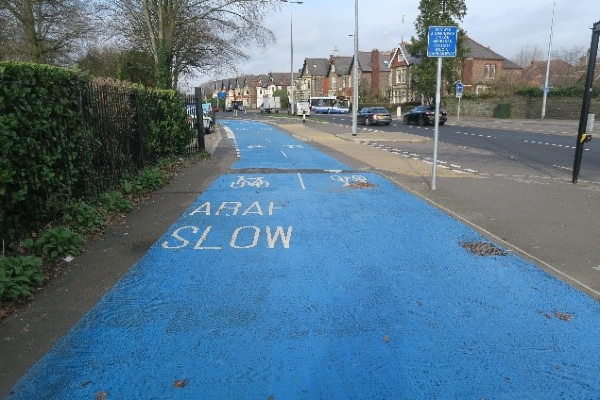
8.1 Cycling routes form a major component of active travel routes and vary from shared use paths to dedicated segregated cycle lanes and on carriageway cycle lanes. In all cases the needs of the cyclists must be addressed and it is not acceptable or reasonable to simply just erect a ‘cyclists dismount’ sign and expect cyclists to use the pedestrian routes. In addition this will cause significant issues for people using adapted cycles as mobility aids.
8.2 In defining cycle routes through street works and road works sites consideration shall be given to the carriageway lane widths and the length over which the traffic management extends as well as to the safety of any temporary transition points between on and off-carriageway facilities.
8.3 In designing traffic management layouts any identifiable risks should be designed out so that any hazard is removed or adequately mitigated. Active Travel includes everyone who cycles and this will cover persons of any age or physical condition as well as those who are considering taking up cycling for the first time. It should accommodate children who can travel independently from the age at which they start secondary school.
8.4 More guidance is given in Part 2.

Photo courtesy of Sustrans.
9. Parking on footways
9.1 Parking on footways and pavements can obstruct and seriously inconvenience pedestrians, disabled people and people with wheelchairs, mobility scooters, prams and pushchairs.
9.2 Unpredictable hazards such as cars represent a significant danger and potential risk of injury to all groups of pedestrians exercising a lawful right to use the highway.
9.3 Where footways are designated as shared use, cyclists will be present on the footway and this creates a potentially dangerous situation where both pedestrians and cyclists are restricted to a narrow width past a vehicle obstruction.
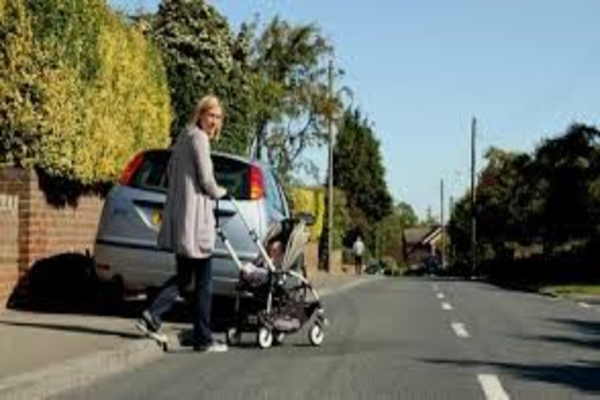
9.4 Drivers who use the footway for parking may think they are doing the right thing by keeping the carriageway clear, but fail to realise the consequences of their vehicle now blocking the footway. The result is that blind and partially sighted people will not be aware of the obstruction until it is too late and consequently parked vehicles introduce a significant risk of injury from collisions. This is unacceptable on all routes, including active travel routes.
9.5 'Footway parking’ refers to vehicles parked wholly or partly on the footway (Road Traffic Act 1988). As well as creating obstacles, this can result in additional costs for local authorities to repair damage to modular paving, concrete and pavement surfaces. In addition, parking and vehicles being driven on footways can cause damage to statutory undertakers’ apparatus and surface covers which have not been designed for this purpose.
9.6 A mix of criminal and civil sanctions are available to police and local authorities to enforce restrictions on footway parking. Parking on footways was banned in London in 1974, and it’s prohibited for large goods vehicles across England but not in Wales. Legislation is being considered in Wales
9.7 The 'Safety at street works and road works: a code of practice 2013' (the Red Book) provides guidance to ensure no road user including pedestrians and cyclists are put at risk by works for road purposes and street works. The code includes specific requirements to prevent obstruction of footways and cycle routes by works vehicles.
10. Skips and scaffolding
10.1 Under the Highways Act 1980 (s139 and s169) all placements of skips and scaffolding on the public highway network must be approved by the local highway authority before placement on the public highway. Once approved a skip permit or scaffolding licence is issued to the relevant provider. Local authorities use terms and conditions within their permit or licence stating:
- Skips: A skip shall be deposited on the carriageway outside the premises detailed in the permit and shall be positioned so that it does not: impede the surface water drainage of the highway; cause damage to the highway; obstruct access to any manhole or the apparatus of any statutory undertaker. Skips placed on the highway require safety lights and markings on or around the skip which could include; reflective markings, traffic cones, night-time safety lamps and the name and telephone number of the skip hire company. Additional consideration must be made if there is a cycle lane within the carriageway as a skip will completely obstruct the lane. Traffic management will be required to divert the cycle lane past the skip.
- Scaffolding: The scaffolding must be lit, and a pedestrian walkway of minimum width of 1.2m provided to the satisfaction of the local highway authority. The scaffolding shall not reduce the effective width of the footway. If the footway is a shared use route, additional provision needs to be made to accommodate cyclists, such as signing or additional delineation on the shared use path. The scaffolding shall not obstruct access to statutory undertakers’ underground chambers, boxes, manholes, hydrants etc.

11. Builders’ materials
11.1 Similar to skips and scaffolding, builders’ material (bricks, sand etc.) stored on the public highway must be licensed under the Highways Act 1980 (s171) by the local highway authority. Materials cannot be stored on double yellow lines or in bus or cycle lanes. A highway authority should not give consent for obstruction of a lane / restriction subject to a Traffic Regulation Order. In the event of this situation arising, an alternative location in a side road should be considered.
12. Hedges, trees and shrubs overhanging the public highway
12.1 Overhanging vegetation (hedge, tree or shrub includes vegetation of any description) is a particular hazard for blind and partially sighted people, but it can also cause problems for any cyclists or pedestrians. Vegetation reduces the effective width of an active travel route as cyclists will need to give additional clearance to this obstruction. Overgrown vegetation growth can affect sightlines on bends and reduce the usable width.
12.2 The owner or occupier of a property should ensure that the highway adjacent to a property is not obstructed by vegetation from their property. Local authorities have powers under the Highways Act 1980 (s154) to serve notice either to the owner of the overgrown vegetation or to the occupier of the land on which it is growing, requiring them to lop, cut or remove the cause of the danger, obstruction or interference.
12.3 The owner of the hedge, tree or shrub or the occupier of the land has a period of 14 days to comply with the notice (or appeal to the magistrate’s court) after which time the authority may carry out the work and recover the expenses reasonably incurred by them in so doing from the person in default.
12.4 Disturbance of the surface of the footway or cycleway due to root growth can create trip hazards and will affect ride quality. Un-swept leaves can present slipping/skidding hazards in wet weather. The maintenance regime should be appropriate for an active travel route.

Photos clockwise: 1. bag of sand on the roadside 2. overhanging unkept bushes on pavement 3. water spilling onto the public highway 4. residential pavement. There is rubbish on the pavement and a van parked up limiting the space for a mobility scooter, wheelchair or buggy to get past.
13. Discharge of water onto the public highway
13.1 It is an offence to fail to comply with a notice requiring an occupier of premises to construct or erect and thereafter to maintain such channels, gutters or downpipes as may be necessary to prevent a) water from the roof or any other part of the premises falling upon persons using the highway, or b) so far as is reasonably practicable surface water from the premises flowing on to, or over, the footway of the highway is an offence under the Highways Act 1980 (s163). Water on the footway can cause a significant danger to road users, particularly during the winter months. Water flowing onto a ‘salted/gritted’ road represents a particular danger, as the running water can wash the de-icing salt from the road surface - allowing it to freeze. Works promoters working on the public highway should take measures to prevent water flowing onto nearby roads, footways and cycle ways.
14. Street and cafe furniture
14.1 Many items of street furniture, including tables and chairs, hanging baskets, bollards and lamp posts, appear on highways for amenity and aesthetic reasons.
14.2 Local authorities have discretionary powers under the Highways Act 1980 (s115E) to licence pavement cafes. In consideration of granting such a licence a balance should be achieved between promoting urban centres and their commercial viability with the needs of the road user, particularly disabled people. Local authorities should consider their duty to safeguard all road users when exercising any licencing power that can affect the road network.
14.3 Local authorities should ensure that licencing requirements are appropriately enforced to ensure that all cafe furniture is licensed, with care being taken to ensure that the tables and chairs are adequately cordoned off and do not constitute a hazard or unreasonable obstruction of the footway.
15. Highway street furniture
15.1 Under Highways Act 1980 (s175A) local authorities are required to have regard to the needs of blind and disabled persons when placing lamp-posts, bollards, traffic-signs, apparatus or other permanent obstructions in a street.
15.2 The Active Travel Design Guidance (s4.7.6) also refers to “unnecessary and badly placed street furniture” and recommends that, where there are active travel routes, the amount of street furniture should be minimised with remaining items located in a street furniture zone out of the pedestrian flow.
15.3 Permanent street furniture which is sensibly placed, like railings and benches, can be useful navigation aids for blind and partially sighted people. However, problems are caused when they are poorly placed and managed, overused, or when the obstacle itself is hard to see or detected.
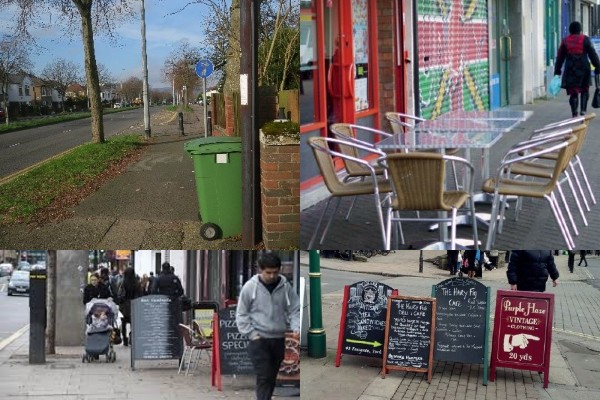
Photos clockwise: 1. rubbish bin obstructing pavement 2. Tables and chairs outside a cafe on public highway 3. sign cluttered footways 4. Photo signs obstructing public footways.
16. Illegal signs and footway obstructions
16.1 It is essential for many people, including blind and partially sighted people, to have a clear route to walk along a footway. Walking past shops can often involve a risk of injury from advertising boards spread across the footway, sometimes causing a dangerous obstruction.
16.2 Under the Highways Act 1980 (s137, s149 and s152) an unlawful interference with highway may constitute an obstruction of the highway or a nuisance. Action can be taken by the local authority to remove unauthorised signs, displayed goods and other items when a footway or pedestrian area is obstructed to the extent that pedestrians are inconvenienced. Signs and other items can interfere with the visibility for motorists and restrict footway widths forcing pedestrians into the road, either directly or because of the number of pedestrians. Signs and other items can themselves present a significant hazard to pedestrians.
16.3 Under Town and Country Planning (Control of Advertisements) Regulations 1992, it is an offence to display an outdoor advertisement without the consent of the local planning authority. There are a number of categories of deemed consent, but A-boards do not appear to fall under any of these. In order for consent to be granted, the advertisement would also need the explicit consent of the highway authority.
17. Bus services
17.1 Sustaining bus services while street works and road works are being undertaken is a key priority for local authorities. Therefore, every effort should be made to ensure services remain unaffected, especially as bus routes form part of the integrated transport system of which active travel is a key component. Where that is not possible, temporary measures should be considered, including:
- Planning traffic management phases to avoid bus stop closures. Temporary bus stop facilities should be provided where this is not possible.
- Continuation of a dedicated bus lane. Where there are a high number of bus services, consideration should be given to retaining a dedicated facility for buses only and placing other motorised vehicles on diversion.
- Keeping diversion routes to an absolute minimum.
- Supplying an alternative shuttle bus service. This may be using a smaller-sized mini-bus that is able to navigate around the street works or road works site, or a smaller bus on a short local diversion away from the works.
- Provision of a banksman where buses have to turn or manoeuvre in areas restricted by works for road purposes and street works.
17.2 Works promotors will need to understand the impacts to both journey times and the cost implications to the operators when designing proposals. Local authority public transport teams will be able to provide information on the predicted number of bus passengers who may be impacted by restricting bus journeys. Access through the street works or road works site during construction may also be a cause of delay to bus passengers, whether along the route or by suspending bus stops and bus lanes.
17.3 Separate approvals are required for suspending bus stops and bus lanes. Bus lanes can be suspended by a temporary suspension request.
17.4 All vehicle types should be able to negotiate a street works or road works site layout. Local authorities may require that a swept path analysis is carried out to establish this is possible, especially where long wheel-based rigid and articulated vehicles are involved. As with bicycles, there are minimum widths set in place so buses and other large vehicles can negotiate traffic management layouts.
17.5 Costs incurred which are in connection with or a consequence of a temporary prohibition or restriction of traffic on a road may be recoverable from the works promoter under section 76 of the New Roads and Street Works Act 1991.
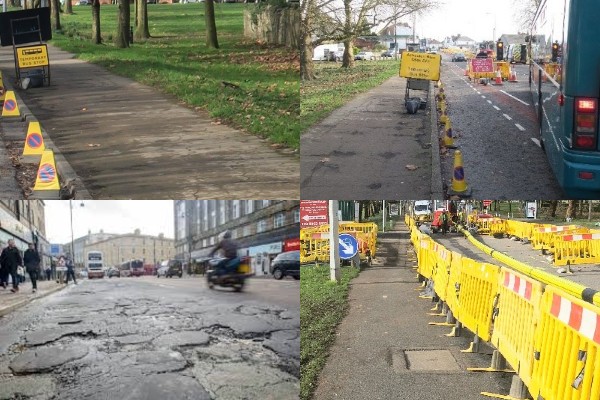
Photos anticlockwise: 1. road signs on the public footway 2. temporary bus stop using signs and bollards on or in the road footwell 3. poor road surface 4. excavation works taking place next to the road, narrowing the pavement.
18. Surface quality
18.1 Road works planners should be mindful of the particular vulnerabilities that pedestrians and cyclists encounter such as uneven, slippery or excessively rough surfaces or planed surfaces where carriageway resurfacing work is being carried out. If pedestrians or cyclists are to be directed away from an active travel route, a risk assessment should be undertaken to ensure they are not being diverted onto hazardous surfaces and/or raised ironwork. If they are to be directed via signage onto a diversion route, then the surfacing on the alternative route should be assessed and made safe if necessary before the diversion is used.
18.2 Damage to footways and cycleways should be identified within the highway authority’s inspection regime and given an appropriate category for repair. Temporary repair and / or signing and guarding should be immediately installed prior to a permanent repair.
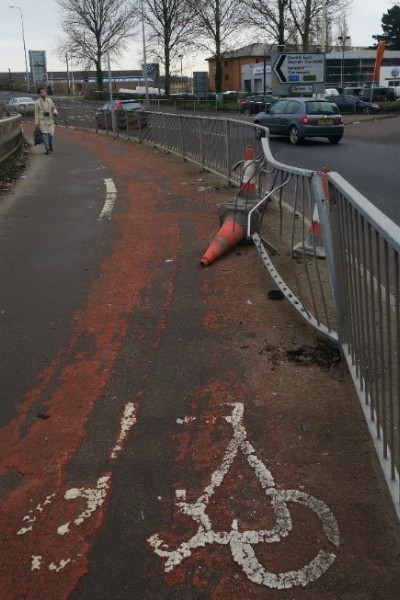
Part 2: Operational guidance for street works and road works
19. Walking routes
19.1 The available width is a major consideration for pedestrian routes, especially in busy urban areas where pedestrian flows are high as reduced width sections may cause an unacceptable pinch points, preventing pedestrians from passing each other. These problems are exacerbated for wheel chair users and pedestrians with pushchairs, or similar. The minimum footway width shall usually be 1.5m. A width of 1.2m is permitted where the footway is temporarily diverted onto a protected route within the carriageway.
19.2 Any interface between pedestrians and cyclists must be carefully managed. Blind and partially sighted pedestrians may have no way of knowing they are now sharing space with cyclists and therefore some form of segregation should be provided.
19.3 When excavation works are being carried out in a footway, pedestrian access should be maintained where pedestrians are diverted onto a temporary footway in the carriageway. It should be noted that guide dogs are trained to guide their owner to the kerb edge if the way forward appears to be blocked. It is therefore essential that the pedestrian route is clear and easy to navigate or else a guide dog may inadvertently guide their owner the wrong way.
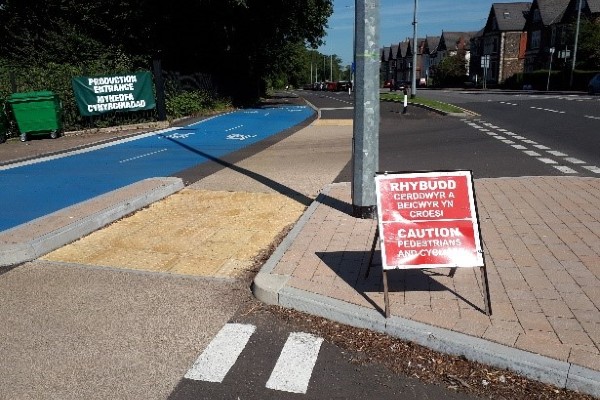
19.4 Blind and partially sighted pedestrians may use the line of barriers as a tapping rail to navigate along the pedestrian walkway. It is therefore essential that this ‘edge’ is maintained through the length of the works. Temporary measures such as marker tape attached to cones will not provide a clear delineator for blind and partially sighted pedestrians.
19.5 Pedestrian crossing facilities should be maintained where possible. If it is necessary to divert pedestrians onto the opposite footway, then placing a ‘Footway closed’ sign at the works and an advance ‘Footway closed ahead’ sign at a location where it is safe for people to cross the road (possibly with the use of portable pedestrian crossing facilities) should take place.
19.6 Footway ramps should be used to enable pedestrians using mobility scooters, wheel chairs and push chairs to negotiate the kerb safely. When the works are temporarily closed e.g. overnight, small excavations (less than 700mm width) can be bridged by footway boards to enable a footway to be reopened for pedestrian usage. The footway boards should usually be 1.5m wide (1m minimum unobstructed width is acceptable at confined street works or road works site).
19.7 Footway boards should be securely (rigidly) fixed and footway ramps should be fixed in position as detailed in the 'Safety at street works and road works: a code of practice 2013' (the Red Book). When anchor holes are made in the footway surface they shall be reinstated as detailed NRSWA 1991 Specification for the Reinstatement of Openings in Highways. The relevant section (s11.5 Test Holes 1b) and 2a)) states:
- Test holes up to 25mm diameter shall be reinstated to an immediate permanent standard.
- In paved surfaces, test holes shall be reinstated using a fine aggregate, bound with cement or bitumen for the upper layers as appropriate and compacted in layers 100mm thickness, or less, to finish flush with the surface.
19.8 Footway boards are not suitable for vehicular traffic and shall only be used on footways to maintain pedestrian access.

19.9 Footway boards and ramps can be secured in various different ways depending upon the type of board or ramp. These include external fixings such as pinning with a specially designed nail for fixing plates, internal locking mechanisms which grip the trench sides and sand bags placed on a mounting plate which is used to secure the board or ramp
19.10 The 'Safety at street works and road works: a code of practice 2013' (the Red Book) must be observed when setting up a street works or road works site and clearly states: ‘where possible the vehicle should be parked off the road in a position that does not obstruct a footway or cycle route’. On arrival at a street works or road works site, works promoters should park their vehicle safely before unloading or setting up signs. Works promoters should not obstruct a footway or cycle route when parking off the road, and respect access to premises and driveways.
19.11 The setting out and maintenance of the signing, cones and barriers is critical in providing clear path through the works. Indicators for the transition from the normal street scene into the street works or road works environment should be placed at either end of the works and the alignment of barriers or cones should be installed to provide an ‘edge’ or tapping rail for a blind or partially sighted person to use their cane to guide them along a route and up and down footway ramps.
19.12 Operatives should be mindful of where they place road signs as these can often unintentionally become an obstruction. For example if there is a cycle lane the operative may place signs on the footway in order to keep the cycle lane open, but in doing so causes an obstruction on the footway which may introduce a hazard for a pedestrian, especially if they are blind or partially sighted.
19.13 Operatives should be mindful of using noisy equipment in close proximity to disabled people. For example many blind and partially sighted people use hearing to navigate around works and these senses can easily be drowned out by heavy machinery. Operatives could temporarily cease works to enable a user to pass by the works with greater ease.
19:14 Works should always be designed such that a disabled person can navigate the works unassisted, but if operatives wish to aid a pedestrian they should follow appropriate protocols and explain verbally what they are going to do.

20. Cycling through street works and road works
20.1 In implementing the traffic management layouts any identifiable risks should be designed out so that any hazard is removed or adequately mitigated. It is necessary to consider everyone who cycles. This will cover persons of any age or physical condition as well as those who are considering taking up cycling for the first time. It should accommodate children who can travel independently from the age at which they start secondary school.

Photo courtesy of Sustrans.
20.2 When works occupy an area in the carriageway (this may include bus lanes) where there is no permanent provision for cycles, either at the location or in close proximity to the approaches to the street works or road works site it is not normally expected that a temporary cycle lane would be required for the works. This is unless the road layout and/or workspace requirements place cyclists into a more vulnerable position sharing space with motor vehicles as identified in a risk assessment.
20.3 Where there is an identifiable increased risk to cyclists, additional features should be provided such as temporary carriageway markings, light segregation such as wands, or physical segregation such as barrier fencing. Risks may include heavy traffic flows, poor surface quality, construction traffic movements, or just the high volume of cyclists. A key consideration in addition to risk will be the available space on the carriageway and the resulting lane widths. This should be balanced with the scale of the works and the time and disruption the extra traffic management will take to set up.
20.4 However, sections of the road network exist in many locations where no extra cycling provision is required provided lane widths are generous and hazards are low. In these circumstances the traffic management may look typically generic with no extra measures for cyclists, except for signing to warn of narrow lanes. It is important that safety zones with an appropriate taper are provided (see The 'Safety at street works and road works: a code of practice 2013' (the Red Book)) so that cyclists do not suddenly swerve into the path of other vehicles. It is always necessary to consider the width of the traffic lanes and how close vehicles will come to encroaching onto the path of the cyclist. The street works or road works site length should be kept to a minimum to reduce the impact on general traffic and discomfort for cyclists.
20.5 However, it is not always possible to maintain the same level of service for cyclists due to the physical constraints of the highway. Essentially this comes down to the available lane width where cycles are required to share space on carriageway with motor vehicles as they pass the road or street works site. To minimise the risk arising from cyclists being overtaken too closely in a narrow lane and to promote increased comfort levels for cyclists, the ‘Narrow lane do not overtake cyclists’ bilingual sign should be used. In addition to the actual width, the alignment through the road and street works should be considered as there is also a greater risk to cyclists at bends, pinch-points, chicanes and corners.
20.6 The available lane widths will determine whether the cyclist proceeds in the primary road position or the secondary road position. The primary road position is where the cyclist rides in the centre of the lane within the traffic flow. This is necessary for lane widths of 3m and less. The secondary road position is where the cyclists rides 0.5m – 1.0m from the edge of carriageway and there is sufficient space for vehicles to overtake. This is achievable for lane widths greater than 4.0m. Traffic management should not be set out with lanes widths between 3.2m and 3.9m as drivers will be tempted to pass cyclists with insufficient clearance. In such cases it should be made clear with signage that it is not permitted to overtake cyclists.

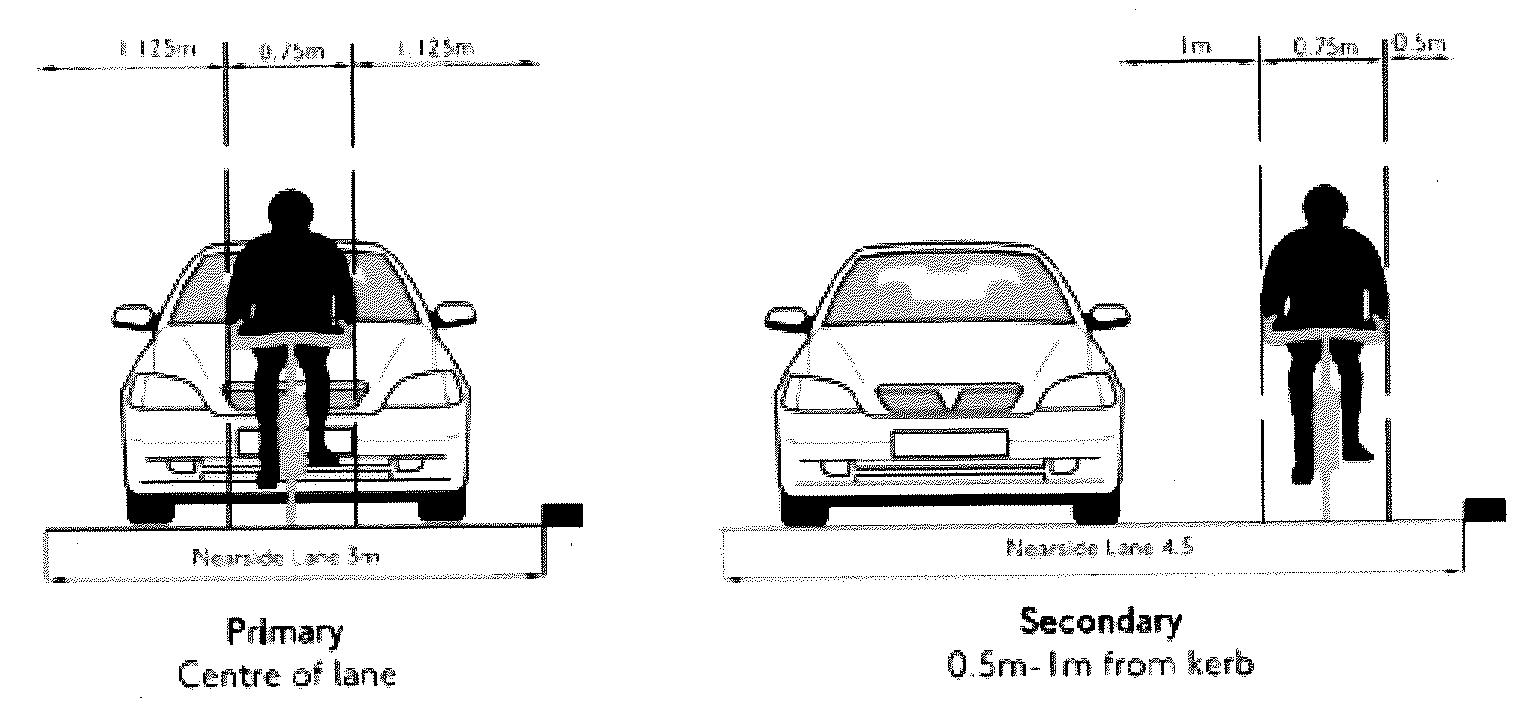
20.7 The works promotor may consider reducing speed limits where narrow lane widths are used preventing motor vehicles from passing cyclists safely. In some circumstances speed camera enforcement could also be considered.
20.8 Long stretches of traffic management can become intimidating for cyclists and frustrating for motorists, especially if the cyclist is using the primary road position, so where possible a protected route should be provided as described in 21.2.
20.9 Where the works promoter proposes the use of a temporary speed restriction, this should take into consideration the presence of cyclists through the works.
20.10 When considering the length of traffic management arrangements (and inter-green times on temporary traffic signals, see 21.9), works promoters should be mindful of the likely speed of cyclists passing through the works as their speed may be adversely affected by gradients. Consideration should be given to phasing the works in reduced lengths of road space occupation, and storing materials and plant away from cycle routes with a high demand. This should be balanced against the potential increase in cost and duration of the works.
20.11 The works promoter should be mindful of the space required for cycling as physical barriers such as pedal height and handlebar height can be especially hazardous. Extra width should be provided to ensure sufficient clearance. Detailed information on space required for cycling is set out in 12.17, 12.18 and 12.19 of the Active Travel Act Guidance.

20.12 Where a works promoter is using shuttle working: either stop/go or temporary traffic signals, these should be set up to give cyclists sufficient opportunity to pass safely through street works or road works site with the appropriate inter-green times used to prevent collisions or unsafe passing with oncoming motor vehicles in a shuttle lane. 10mph to 15mph is reasonable for most cyclists, but this can be reduced to around 7mph on uphill gradients. On descents cyclists may be travelling at 25mph or more. In addition the works promoter needs to take into consideration any cycle routes that many join the route within the shuttle working area and place appropriate warning signs on each route.
20.13 Where a works promoter is using convoy working, the convoy vehicle shall drive to the stated speed limit, usually 10mph (a temporary traffic order is required for convoy working). A speed of 10mph should be adequate for cyclists negotiating the works, but the banksmen controlling the traffic signals must ensure cyclists have cleared the works before releasing the convoy vehicle escorting the opposing flow. The banksman must be aware of the differing abilities of cyclists and allow a situation where a slower cyclists feels under pressure to occur.
12.14 Where there is a cycle lane within the carriageway that will become obstructed by the safety zones or working area, then it will be expected that the facility will be maintained through the temporary works, unless it is deemed there is no risk to cyclists.
20.15 Where the temporary segregation terminates, care needs to be taken to ensure cyclists re-join the carriageway in a safe manner and location. Both drivers and cyclists need good visibility of each other and the alignment of their respective approaches so as to ensure a smooth transition. If it is not viable to provide delineation or segregation, designers should consider risk mitigation using other measures, such as using hazard warning signing, separation of road users by diverting motor vehicles, or cyclists via different routes, or speed reduction.
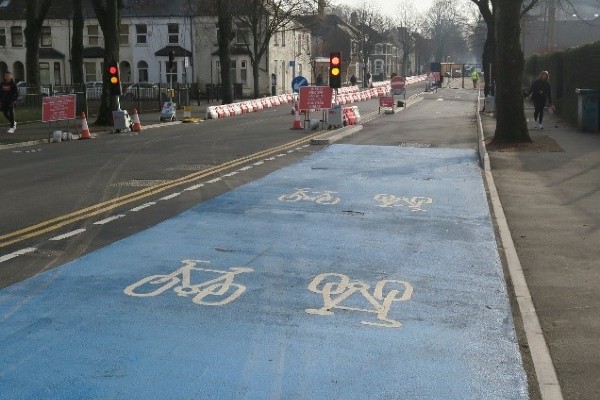
20.16 Road works planners need to be mindful of cyclist behaviours and the possibility of cyclists entering and exiting the facility between traffic cylinders. Where it is desirable to retain cyclists in a lane or prevent access/egress along the lane, then continuous barriers are advised.
20.17 When specifying the most appropriate arrangements, consideration should be given to clearance times for cyclists, particularly on steep hills. When a traffic management drawing is submitted with portable traffic signals, the drawing and location should be assessed and signal timings supplied to the local authority. Otherwise, the works promoter should operate them as agreed with the local authority or in line with the recommendations of the Department for Transport ‘An Introduction to the use of Portable Vehicular Signals’ booklet, which is also known as the ‘Pink Book’.
